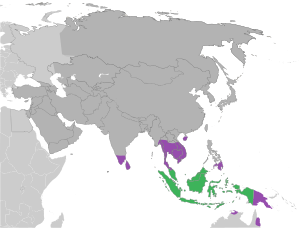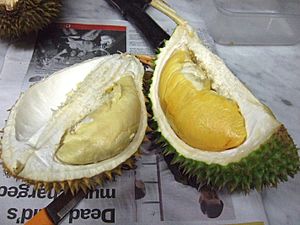Durio zibethinus facts for kids
Quick facts for kids Durio zibethinus |
|
|---|---|
 |
|
| Scientific classification | |
| Genus: |
Durio
|
| Species: |
zibethinus
|
 |
|
| Native distribution of D. zibethinus Exotic distribution of D. zibethinus | |
| Synonyms | |
|
|
Durio zibethinus is the most common type of durian tree. It's famous for its large, spiky fruit, also called durian. This fruit is known for its very strong and unique smell. Some people love the smell and find it sweet. Others find it too strong or even unpleasant.
The durian's smell can be so powerful that it's sometimes banned from hotels and public transport in places like Southeast Asia. There are about 30 different kinds of Durio trees, but D. zibethinus is the only one you'll usually find in international markets. Many people have their favorite types of durian, which can be more expensive.
Contents
What Does Durian Look Like?
The wood from the D. zibethinus tree is a reddish-brown color.
How Durian Trees Grow
Durian flowers are visited by bats. These bats eat the pollen from the flowers. This helps the flowers make seeds. The flowers open in the afternoon and release their pollen in the evening. By the next morning, most parts of the flower fall off. Only the part that will become the fruit remains.
Eating Durian Fruit
| NCBI genome ID | 57226 |
|---|---|
| Ploidy | diploid |
| Genome size | 715.23 |
| Number of chromosomes | 56 |
| Year of completion | 2017 |
For hundreds of years, people in Southeast Asia have grown many different types of durian. These types are called cultivars. They used to grow them from seeds. Now, they often use special methods like grafting. This means attaching a part of a good durian tree onto another young tree.
Different durian types can be told apart by their fruit's shape or the shape of their spikes. People often have a favorite type. These special types can cost more money.
Popular Durian Types
Most durian types have a common name and a code number, like "D99". Some popular types include:
- Kop (D99)
- Chanee (D123)
- Mon Thong (D159)
- Kan Yao (D158)
Each type has its own unique taste and smell. In Thailand, there are over 200 different durian types. Mon Thong is very popular for its creamy, sweet flesh and milder smell. Chanee is good because it can resist certain plant diseases. Kan Yao is liked for staying sweet and less smelly for a longer time.
In Malaysia, over 100 types have been officially recognized since the 1920s. A newer popular type is called Musang King.
New Durian Discoveries
Scientists are always working to create new durian types. In 2007, a Thai scientist created Chantaburi No. 1. This type doesn't have the strong durian smell. Another type, Chantaburi No. 3, develops its smell a few days after being picked. This means it can be transported without the strong smell, but still satisfies people who like it.
In 2012, two more types without the usual smell were shown to the public in Thailand. They are called Long Laplae and Lin Laplae.
Besides the tasty fruit pulp, the seeds of the durian can also be eaten. They are usually roasted first.
Durian Nutrition Facts
|
||||||||||||||||||||||||||||||||||||||||||||||||||||||||||||||||||||||||
Durian fruit is full of good nutrients. It has vitamins like Vitamin C and B vitamins. It also contains minerals like potassium, copper, and manganese.
See also
 In Spanish: Durio zibethinus para niños
In Spanish: Durio zibethinus para niños


